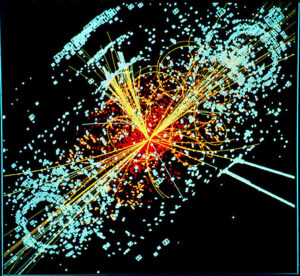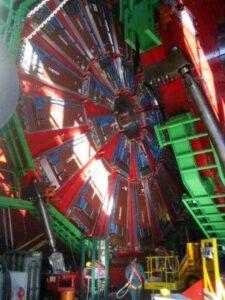It’s the Higgs, baby!
 July 4, 2012 was a very big day. Yes, it was Independence Day in the United States, but that comes every year. On July 4, 2012, The European Organization for Nuclear Research (CERN) officially announced that they have observed a “particle consistent with long-sought Higgs boson”. This is huge for particle physics – a culmination of 50 years of experimentation. To quote from the press release:
July 4, 2012 was a very big day. Yes, it was Independence Day in the United States, but that comes every year. On July 4, 2012, The European Organization for Nuclear Research (CERN) officially announced that they have observed a “particle consistent with long-sought Higgs boson”. This is huge for particle physics – a culmination of 50 years of experimentation. To quote from the press release:
“We observe in our data clear signs of a new particle, at the level of 5 sigma, in the mass region around 126 GeV. The outstanding performance of the LHC and ATLAS and the huge efforts of many people have brought us to this exciting stage,” said ATLAS experiment spokesperson Fabiola Gianotti, “but a little more time is needed to prepare these results for publication.”
 Why am I posting this here? Well first off, I am really freaking excited!!! This finding completes the Standard Model for particle physics giving scientists a much more complete picture and deeper understanding of how matter works. The Higgs boson is what gives matter its mass. (Read the footnote at the bottom if you would like to nerd out with me as to HOW it gives mass.)* This was the whole reason they built the Large Hadron Collider (LHC) and took over 6,000 scientists around the world working together to complete (two teams of 3,000 scientists working independently in isolation). The LHC alone took 10 years to build at a cost of over $9billion – and hypothetically could have created a black hole that would have killed us all.
Why am I posting this here? Well first off, I am really freaking excited!!! This finding completes the Standard Model for particle physics giving scientists a much more complete picture and deeper understanding of how matter works. The Higgs boson is what gives matter its mass. (Read the footnote at the bottom if you would like to nerd out with me as to HOW it gives mass.)* This was the whole reason they built the Large Hadron Collider (LHC) and took over 6,000 scientists around the world working together to complete (two teams of 3,000 scientists working independently in isolation). The LHC alone took 10 years to build at a cost of over $9billion – and hypothetically could have created a black hole that would have killed us all.
More importantly for us, it gives a beautiful example of how science actually works. To quote again from the press release:
“It’s hard not to get excited by these results,” said CERN Research Director Sergio Bertolucci. “ We stated last year that in 2012 we would either find a new Higgs-like particle or exclude the existence of the Standard Model Higgs. With all the necessary caution, it looks to me that we are at a branching point: the observation of this new particle indicates the path for the future towards a more detailed understanding of what we’re seeing in the data.”
The “branching point” of experimentation is one of the things that defines science. This one experiment had the capability to completely FALSIFY the entire Standard Model. Without the results of this experiment, scientists were stuck between the Standard Model and other Higgless models.
The findings don’t “prove” anything. As they state, “the observation of this new particle indicates the path for the future towards a more detailed understanding of what we’re seeing in the data.” It closes off other now known to be false paths so that science can now head towards a better understanding.
Awesome! Congrats CERN and congrats science!
*FOOTNOTE – So subatomic particles (smaller than electrons) have no mass as they move around at speeds close to the speed of light (some evidence suggests that they might even move faster than the speed of light). As all matter is made up of these particles, and there is more space than particles in any given type of matter, there was no way to explain how matter could have “mass”. In mathematical models, the Higgs boson (posited by Peter Higgs) creates the Higgs field. This field has been described as the “water in which subatomic particles swim”. The more resistance the particle encounters in the field, the slower it moves. This slowing of the particle creates mass. Simple right?
